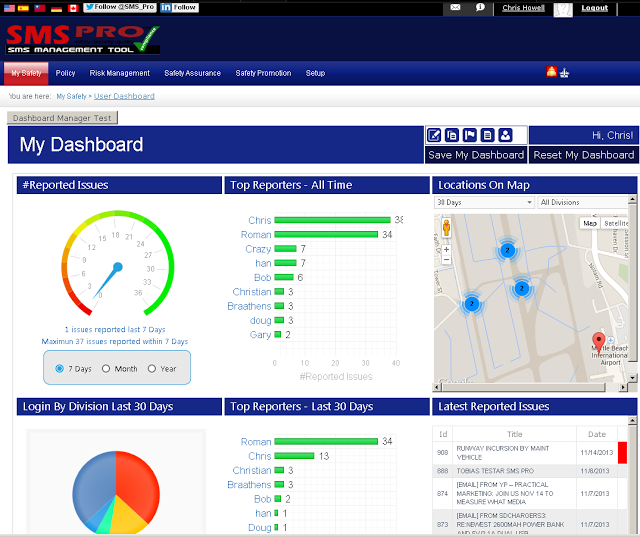Incentives Are the Key to Proactive Risk Management

Incentive (or lack of) will make or break an aviation safety management system (SMS).
Without fail, aviation SMS that perform at a proactive risk management level have specific incentives that fit the needs of the organization.
Immature programs struggle to cultivate incentives for several reasons, including the fact that they are often unaware of how powerful incentives are in creating a performing SMS implementation.
I would go so far as to say that an aviation SMS is simply a collection of aligning and conflicting incentives being managed within formal risk management processes.
Related Articles on Proactive Risk Management in Aviation SMS
- Difference Between Reactive, Predictive and Proactive Risk Management in Aviation SMS
- The Secret Bias That Hurts Proactive Risk Management
- Proactive Risk Management: What Root Causes Say About Management
What Are Incentives in Aviation SMS
Incentives are basically:
- Positive reason to do something
- Positive reasons NOT to do something
- Negative reason to do something
- Negative reason NOT to do something
The difference between positive reasons and negative reasons is that positive reasons are motivated by a place of reward and encouragement, whereas negative reasons come from fear and punishment.
An aviation SMS can fill their policies with negative incentives – and perhaps even look good on paper - but will most likely have a toxic, unhealthy effect on safety culture. Such a safety culture will have an extremely hard time moving from reactive to proactive risk management. We can even say that negative incentives place a dampener on reactive risk management processes in that employees will be less inclined to report minor incidents and close calls.
Here are 7 ways to create positive incentives in your aviation SMS, and create a culture of proactive risk management.
1 – Make Everything About Your SMS Simple

In many ways, having SMS tools that are designed to be quick and straightforward to use such as
- Safety reporting system
- Tracking status of reported safety issues
- Reviewing policies/procedures and relevant organizational documentation
- Delivering and accessing relevant safety information
- Responding to delivered safety information (read files)
- Participating in SMS training
- Offering suggestions to improve operations
- Contacting management about sensitive issues
-does give incentives for employees to engage with the SMS. However, in this case, it is much more about taking away the negative incentive to not engage.
For example, in programs with overly complicated software tools, employees have the negative incentive (frustration, confusion) to not use provided SMS tools.
When tools are readily available and easy to understand, employees are significantly more likely to engage because of the positive incentives (understanding, expediency). Aviation SMS software tools significantly affect safety cultures. While employees may not be over-excited to report mandatory safety concerns, at least they are not enduring needless frustration when they perform their duty to the aviation SMS.
Related Aviation SMS Software Articles
- How to Choose Aviation SMS Software - Educating SMS Professionals
- How Does Aviation Safety Software Improve Safety? - Aviation SMS
- Spreadsheets vs Software for Aviation Safety Management
2 – Give Employees Authority
Authority is a tricky word. In this case, I don’t mean free reign, but rather the kind of authority that is enough to keep tabs on, and yet empowers employees to take action. Things like:
- Give employees power (without fear of punishment) to make executive decision-making privileges in situations that require quick action
- Encourage employees to speak up and be vocal about thoughts and concerns, be it in a safety meeting, or on the front line of the workplace
- Reinforce that you value their opinion (both in words and actions)
- Be very clear about what expectations are for workers, as knowledge and confidence go hand in hand
When it comes down to it, authority is about giving your employees every reason to be confident with what they say and how they act. The workplace should be as emotionally safe for workers as it is physically safe.
3 – Ask Lots of Questions

Questions necessarily involve the interaction of some kind:
- From an aviation safety survey
- In a safety meeting
- During informal discussion
And in all of the above scenarios, two things are happening:
- the safety program is being pushed into employees’ views, and
- they are allowed to share their values.
I think you will agree with me when I say that if there is one thing humans generally love to do, it’s to give their opinion.
Asking questions is an easy way, therefore, to cultivate a sense of being involved, engaged, and demonstrating their opinions are valued. All the while, this organizational attitude is strengthening the safety culture.
Related Aviation Safety Culture Articles
- 5 Characteristics of Effective Aviation Safety Cultures - With Free Survey
- 6 Types of Safety Culture in Aviation Safety Management System
- How Top Management Kills Aviation Safety Culture - With Examples
4 – Squash Unhealthy Corporate Culture Elements
The wrong corporate culture kills safety culture.
Social interactions within the organization like cronyism and nepotism are terrible influences on a healthy safety culture. These practices involve management showing favor to individuals based on who are family, friends, or share the same ideologies (political, religious, etc.). Both of these social practices are certain to isolate people and give employees negative incentives to disengage from management’s policies.
But there are even more insidious expressions of corporate culture that, unfortunately, are easy to go unnoticed. For example:
- Making decisions only from the point of view of management
- Having little personal interaction outside of management
- Putting the needs of management above employees
Management can easily drift into such behaviors over time without even realizing it. The consequence is that a definite wall is built between the management and the general workforce. As an example, we commonly see this phenomenon, let's consider hazard reporting forms that management provides to employees to use in the company's safety reporting system. Too often, we have managers ask for us to create custom reporting forms that will allow management to collect all the information they can possibly foresee needing whenever an employee submits safety reports.
If you have ever had to fill out pages of paperwork when visiting the hospital or doctor's office, you will recognize that these forms have the purpose of collecting all pertinent information about a patient. If doctors don't collect all relevant information, they could inadvertently engage in a harmful medical practice, such as
- administering the wrong drugs; or
- performing a needless operation.
In the case of the doctor's office, they need the information to treat the patient properly. A safety reporting form does not require the same detail as a safety reporting form. In the case of the doctor's office, the doctor doesn't care if the patient keeps coming back in and filling out forms again. However, with employees reporting safety issues, employees don't want to spend thirty minutes filling out required fields just so management gets all the required information the first time.
Very long, detailed safety reporting forms benefit management at the cost of your reactive and proactive risk management processes. No employee likes very long, detailed reporting forms.
Management doesn't realize the harmful effects that these long, over-detailed, safety reporting forms have on safety culture. Employees will not willingly and satisfactorily fill out long reporting forms. They may fill out the long reporting form once, but anytime a minor incident or close call occurs, these same employees are not interested in suffering for thirty minutes just to save management a few extra minutes on following up.
Safety reporting forms should be designed with the end-user in mind. Keep them short to encourage repeat behavior.
Employees need to have the incentive that they aren’t simply “tools” to do management’s bidding but are actively viewed as essential contributors to the successful performance of the aviation SMS.
Have You Read
- 5 Simple Tips to Improve Aviation Safety Reporting Cultures
- Understanding Role of Hazard Identification Training and Safety Reporting Forms in Aviation SMS
- Examples of Good Hazard Reporting Forms in Aviation Safety
5 – Recognize Individuals

Recognition always goes a long way, no matter the context. Recognition could be:
- As simple as a personal thank you or compliment
- As daily as an informal interaction with an employee
- As formal as a reward of some kind
- As traditional as a regular feature in print, such as in an aviation safety newsletter or company email
No matter how small or silly the gesture, everyone responds to recognition. It is perhaps the more powerful form of positive reinforcement, as well as an easy, but extremely efficient means of generating incentives.
6 – Be Vocal That Safety Comes First, Production Second
One of the most powerful negative incentives in any organization is the protocol that production comes before safety. It’s tough because production means money, and organizations need it to survive. Speaking up or causing delays can end up costing a lot of money – and the initial concern may turn out to be harmless.
In such environments, small concerns are generally overlooked for fear that calling attention to a potential safety concern will make an employee look stupid or waste everyone’s time. Or, if management is constantly pressuring employees for more production, workers may accidentally miss a safety concern. And let’s be honest, usually the “possible concerns” generally don’t end up being a big problem, but sometimes they are extremely expensive and deadly.
A great incentive to give employees involvement is to always err on the side of safety, and reward such behavior. Safety overproduction puts a safety culture and a mindset of safety first, and when that happens, employees are better prepared to practice proactive risk management.
7 – Final Thought: Getting to the Ultimate Incentive
The ultimate incentive in any organization is simple:
- Everyone else is doing it
To some degree, safety promotion and safety culture are about making this single fact brim with positive incentives. Everyone is reporting. Everyone is speaking up. Everyone is watching out for each other. Everyone is friendly with management.
When everyone is doing [insert your positive point], it’s not simply a safer environment that practices proactive risk management, but also a positive place to work. Getting to the ultimate incentive is about picking apart the various incentives in your aviation SMS, and nudging each one in a positive direction.
Non-punitive reporting policies are among the most effective tools to shape a culture. Do you have one?
Does your non-punitive reporting policy require review?
How are your aviation SMS tools? Is your safety reporting system adequate? Are the safety reporting forms easy to use? Does your safety reporting system provide immediate feedback to reporters?
Please watch these short demo videos to determine whether we will be a good fit for your aviation SMS. SMS Pro has been working with aviation service providers since 2007. Let's work together to satisfy your SMS goals and objectives.
Last updated October 2025.








